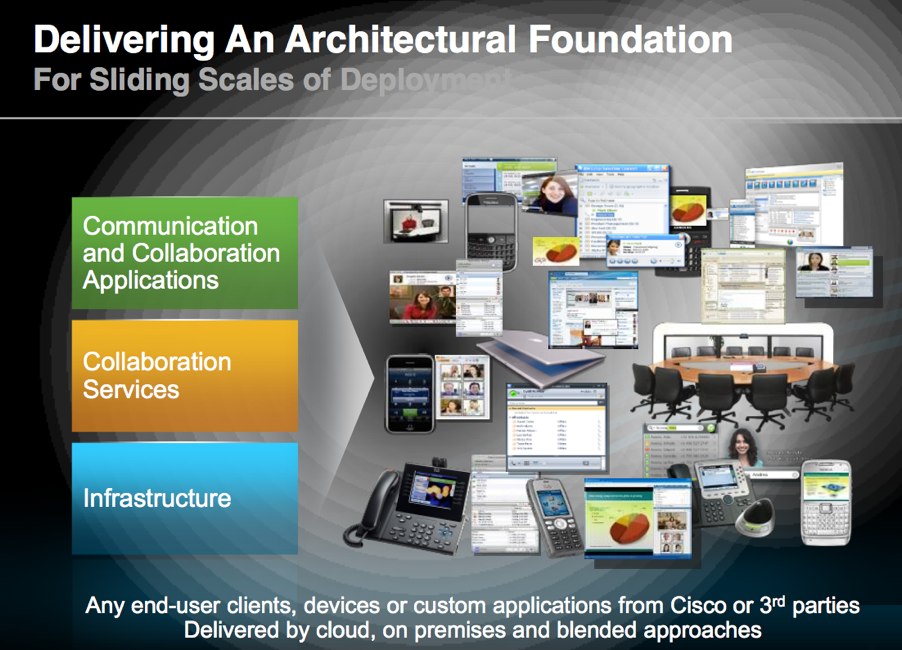Cisco unveils collaboration, e-mail and social tools for the enterprise

Cisco is placing bets on the future adoption of collaboration tools for businesses by unveiling later today a enhanced suite of offerings, including a new social networking software designed for a corporate setting and a new cloud-based e-mail hosting service, as well as video and voice integration into the collaboration platform. (Statement)
The company said that the idea behind the new collaboration platform is to be less "document-centric" and more "people-centric" by working with voice, IM and video to create business-to-business communications - and meetings - more efficient. In part, that includes the ability to bring Facebook-like tools into the mix, but secure them in a way that meets the needs of a company. The company explains its social video system, called Show and Share, like this:
Cisco Show and Share is a social video system that helps organizations create and manage highly secure video communities to share ideas and expertise, optimize global video collaboration, and personalize the connection between customers, employees, and students with user-generated content. It allows organizations to record, edit and share video with comments, ratings,. tagging and RSS feeds, ans speech-to-text transcripts can be uploaded for easy video search and viewing.
The other announcement - Cisco WebEx Mail - stems from the company's acquisition of PostPath and offers a cloud-based system that also has Outlook interoperability. Through its acquisition of Jabber, the company also said it has integrated the XMPP standard to give it a secure but widely available presence in the collaboration tools.
In some ways, Cisco - which has been competing with companies such as IBM, HP and Dell in the data center - is now adding Microsoft, which recently dropped the price of its hosted versions of Exchange, Sharepoint, and Office Communications Server, and Google to its lineup of competitors with these new services. For some time, Google has been pushing its cloud-based apps for businesses and even scored a major deal with city of Los Angeles recently to manage its email system. And now, it's previewing Google Wave, a Web-based, real-time collaboration tool that allows users across the Web to communicate with each other in e-mail like message thread or instant chats and share documents, videos, images, charts and more.
Under the Google Wave approach, users can open the collaboration projects, or "Waves," to anyone over the Internet, allowing collaboration with anyone via the Web. Cisco's new offering also breaks down the walls of the traditional network, allowing users to work with customers, vendors and others who normally might have been locked out of the collaboration process
Cisco said that, upon rollout, its mail offerings - priced "somewhere south of $8 per mailbox per month" but still being finalized - will be cloud-based only while the collaboration platform will reside on-premise. Eventually, the company will offer the ability to split data between the two worlds - on-site and in the cloud - but still sees companies being more comfortable with e-mail in the cloud than they are with collaborative documents and correspondence in the cloud.
The company has been vocal about its visions for the future, notably its belief that video will be "the center of everything" in future communications. With this push into collaboration software, the company is subscribing to the idea that e-mail is losing some of its luster as a tool for conducting business. Anyone who's ever exchanged two dozen emails with a half-dozen people just to set up a meeting knows how ineffective e-mail can be when working with teams.
Cisco has been transforming itself during the economic downturn to be more than just a networking company by the time the economy started to recover. As part of the movement, it's been beefing up its offerings, largely through acquisitions. In October alone, it made three acquisition announcements - $3 billion for Tandberg, a video conferencing equipment maker, $2.9 billion for Starent, a provider of mobile Internet Protocol gear, and $183 million for ScanSafe, an Internet security company.
Last week, it presented Wall Street with better-than-expected first quarter results and said - several times - that it was seeing signs of the beginning of an economic recovery.